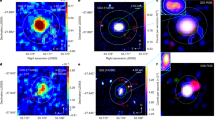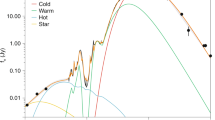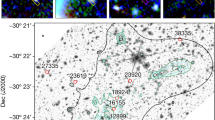Abstract
THE diffuse interstellar bands (DIBs) are spectral absorption features caused by interstellar matter but not identified with any known atomic or molecular lines. Since 1975, when 39 such bands were known1, many more have been detected, and in 1988, about 80 were listed2. They range in frequency from visible (4,430 Å) to very near infrared wavelengths (8,650 Å) (ref. 3), but their carriers—the atoms or molecules that cause them—remain unknown. We have found two new DIBS in the near infrared, near 11,800 Å and 13,200 Å, in the spectra of reddened O, B and A stars. Their full widths at half maximum are 2.7 ± 0.3 Å and 4.0 ± 0.5 Å respectively, and their equivalent widths are 60 and 135 mÅ per magnitude of extinction. The wavelength of the second DIB is a factor of 1.5 longer than that of the longest wavelength band previously identified, which may be an important constraint on the nature of the carriers of these two bands.
This is a preview of subscription content, access via your institution
Access options
Subscribe to this journal
Receive 51 print issues and online access
$199.00 per year
only $3.90 per issue
Buy this article
- Purchase on Springer Link
- Instant access to full article PDF
Prices may be subject to local taxes which are calculated during checkout
Similar content being viewed by others
References
Herbig, G. H. Astrophys. J. 196, 129–160 (1975).
Herbig, G. H. Astrophys. J. 331, 999–1003 (1988).
Sanner, F., Snell, R. Van den Bout, P. Astrophys. J. 226, 460–468 (1978).
Douglas, A. E. Nature 269, 130–132 (1977).
Van der Zwet, G. P. & Allamandola, L. J. Astr. Astrophys. 146, 77–80 (1985).
Léger, A. & d'Hendecourt, L. Astr. Astrophys. 146, 81–85 (1985).
Kroto, H. W. in Polycyclic Aromatic Hydrocarbons and Astrophysics (eds Léger, A., d'Hendecourt, L. & Boccara, N.) 197–206 (Reidel, Dordrecht, 1987).
Léger, A., d'Hendecourt, L., Verstraete, L. & Schmidt, W. Astr. Astrophys. 203, 145–148 (1988).
Kroto, H. W. Nature 329, 529–531 (1987).
Kurucz, R. L. Semi-empirical Calculation of gf Values (Smithsonian Inst., Cambridge, 1981).
Platt, J. R. Astrophys. J. 123, 486–490 (1956).
Puget, J. L., Léger, A. & Boulanger, F. Astr. Astrophys. 142, L19–L22 (1985).
Puget, J. L. & Léger, A. A. Rev. Astr. Astrophys. 27, 161–198 (1989).
Krelowski, J. & Walker, G. A. H. Astrophys. J. 312, 860–867 (1987).
Author information
Authors and Affiliations
Rights and permissions
About this article
Cite this article
Joblin, C., Maillard, J., d'Hendecourt, L. et al. Detection of diffuse interstellar bands in the infrared. Nature 346, 729–731 (1990). https://doi.org/10.1038/346729a0
Received:
Accepted:
Issue Date:
DOI: https://doi.org/10.1038/346729a0
This article is cited by
-
Infrared diffuse interstellar bands in the Galactic Centre region
Nature (2011)
-
The identification of diffuse bands
Astrophysics and Space Science (1996)
-
Detection of two interstellar absorption bands coincident with spectral features of C60+
Nature (1994)
-
Laboratory evidence for highly unsaturated hydrocarbons as carriers of some of the diffuse interstellar bands
Nature (1993)
-
Electronic transitions in C60 and its ions
Zeitschrift f�r Physik D Atoms, Molecules and Clusters (1991)
Comments
By submitting a comment you agree to abide by our Terms and Community Guidelines. If you find something abusive or that does not comply with our terms or guidelines please flag it as inappropriate.



